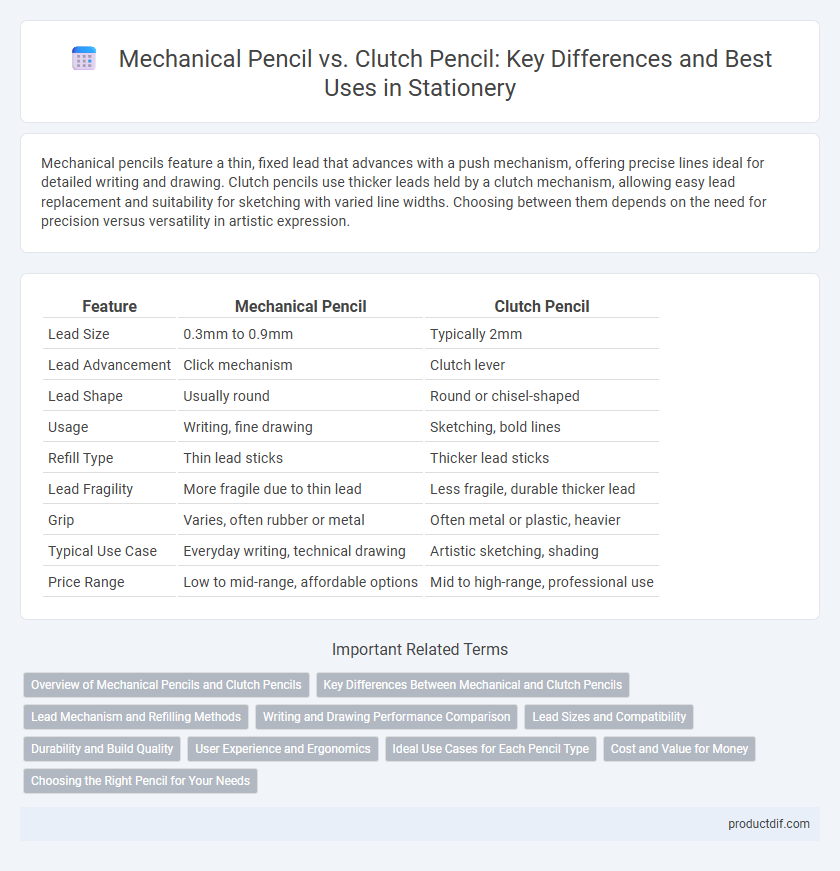Mechanical pencils feature a thin, fixed lead that advances with a push mechanism, offering precise lines ideal for detailed writing and drawing. Clutch pencils use thicker leads held by a clutch mechanism, allowing easy lead replacement and suitability for sketching with varied line widths. Choosing between them depends on the need for precision versus versatility in artistic expression.
Table of Comparison
| Feature | Mechanical Pencil | Clutch Pencil |
|---|---|---|
| Lead Size | 0.3mm to 0.9mm | Typically 2mm |
| Lead Advancement | Click mechanism | Clutch lever |
| Lead Shape | Usually round | Round or chisel-shaped |
| Usage | Writing, fine drawing | Sketching, bold lines |
| Refill Type | Thin lead sticks | Thicker lead sticks |
| Lead Fragility | More fragile due to thin lead | Less fragile, durable thicker lead |
| Grip | Varies, often rubber or metal | Often metal or plastic, heavier |
| Typical Use Case | Everyday writing, technical drawing | Artistic sketching, shading |
| Price Range | Low to mid-range, affordable options | Mid to high-range, professional use |
Overview of Mechanical Pencils and Clutch Pencils
Mechanical pencils feature a spring-loaded mechanism that advances a thin, consistent lead, ideal for precise writing and drawing with minimal sharpening required. Clutch pencils utilize a clutch mechanism to hold thicker leads, allowing for varied line widths and easy lead replacement, preferred for sketching and technical drafting. Both tools offer durable, refillable options that cater to different user preferences in terms of lead size and application.
Key Differences Between Mechanical and Clutch Pencils
Mechanical pencils use a thin, fixed-diameter lead that advances incrementally with a click mechanism, offering precision for detailed writing and drawing. Clutch pencils hold thicker leads secured by a clutch mechanism, allowing for easy lead replacement and broader strokes, ideal for sketching and technical drafting. The choice depends on the required lead thickness, convenience in lead advancement, and specific use cases in stationery tasks.
Lead Mechanism and Refilling Methods
Mechanical pencils use a push-button or twist mechanism to advance thin, standardized lead refills, allowing precise control and easy one-handed operation. Clutch pencils employ a spring-loaded clutch that grips thicker leads, releasing them by pressing the top button to adjust length or replace the entire lead. Refilling mechanical pencils involves inserting small-diameter lead sticks into a narrow chamber, while clutch pencils require loading single thicker leads individually for extended writing or sketching sessions.
Writing and Drawing Performance Comparison
Mechanical pencils provide consistent line thickness ideal for precision writing and detailed technical drawing, featuring replaceable fine leads ranging from 0.3mm to 0.7mm. Clutch pencils use thicker leads, usually 2mm, delivering robust strokes favored by artists for shading and sketching with variable pressure control. Both tools offer distinct performance advantages: mechanical pencils excel in accuracy and neatness, while clutch pencils support dynamic, expressive line work suitable for creative illustrations.
Lead Sizes and Compatibility
Mechanical pencils typically use standardized lead sizes such as 0.5mm, 0.7mm, and 0.9mm, offering broad compatibility with widely available leads suitable for writing and drawing precision. Clutch pencils accommodate thicker leads, often ranging from 2mm to 5.6mm, providing versatility for artists and draftsmen requiring varied line widths and durability. Compatibility depends on the pencil type; mechanical pencils demand specific thin leads, while clutch pencils can hold larger, replaceable leads, making each ideal for different applications and preferences.
Durability and Build Quality
Mechanical pencils typically feature robust plastic or metal barrels designed for long-term use, offering consistent durability and a comfortable grip. Clutch pencils, often constructed with metal housings and a retractable lead mechanism, provide superior build quality, making them more resistant to wear and ideal for heavy-duty use. Both types excel in precision, but clutch pencils generally outlast mechanical pencils in terms of structural resilience and longevity.
User Experience and Ergonomics
Mechanical pencils offer consistent line width and require minimal sharpening, enhancing user experience with precision and convenience. Clutch pencils provide greater lead diameter options and superior durability, catering to artists and professionals needing varied stroke intensity. Ergonomically, mechanical pencils tend to be lighter and more balanced, while clutch pencils often feature a thicker barrel, reducing hand fatigue during extended use.
Ideal Use Cases for Each Pencil Type
Mechanical pencils, known for their consistent fine lines and ease of lead replacement, are ideal for precise technical drawings, note-taking, and everyday writing tasks. Clutch pencils, which hold thicker leads and offer greater lead durability, excel in sketching, shading, and artistic work requiring varied line weights. Selecting between mechanical and clutch pencils depends on whether precision or artistic flexibility is the primary need.
Cost and Value for Money
Mechanical pencils generally offer greater cost efficiency over time due to their refillable leads and durable construction, minimizing frequent replacements. Clutch pencils often provide better value for artists and technical users who require consistent lead thickness and sturdier grip, despite higher upfront costs. Evaluating longevity, lead quality, and personal usage needs ensures optimal value for money between both pencil types.
Choosing the Right Pencil for Your Needs
Mechanical pencils offer consistent line width and convenience with refillable leads, ideal for precise writing and technical drawing. Clutch pencils provide a robust grip on thicker leads, making them suitable for sketching and shading with varied line intensity. Selecting the right pencil depends on your specific use, whether you prioritize precision or artistic flexibility.
Mechanical Pencil vs Clutch Pencil Infographic

 productdif.com
productdif.com